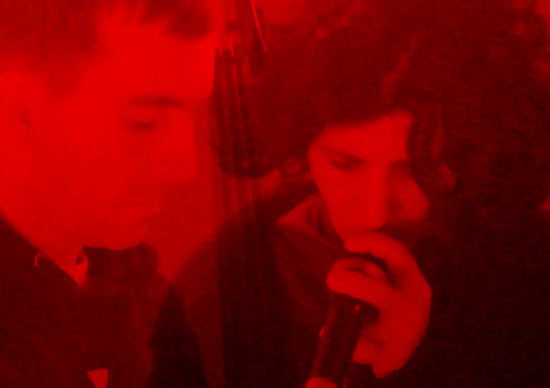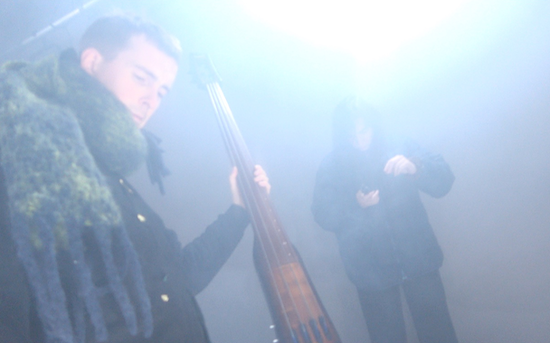In the depths of winter last year, vocalist Dali De Saint Paul and double bassist Maxwell Sterling found themselves recording a strange, almost nightmarish, improvised session for BBC Radio 3’s Late Junction. Suddenly, De Saint Paul – known for her wild, raw performances in HARRGA and her improvisatory nous in EP/64 – did something unexpected. “I started whistling. I was drawn into thinking about summer nights, and warm weather – it enveloped me,” she says. “Then Maxwell found these beautiful chords.”
The track contrasts sharply with other moments recorded during the session which were a darkly psychedelic mixture of looped strings and vocalisations. Accompanying a new series of live audio-visual performances, the pair are finally releasing this extra material (along with the unedited Late Junction performance) as the record Penumbra. “We were able to explore different moods and spirits", Sterling says of that fevered day of recording, “and corners of our instruments we didn’t know were there.”
When the pair were united by Late Junction’s producer Silvia Malnati, neither knew each other’s work. “I think it made it that much more dramatic”, Sterling grins. “It felt even more improvised.” The pairing of double bass and voice, neither of which is bound by fixed pitches, proved an exciting combination. “They occupy quite different ranges, but whistling and open harmonics have a similarity that’s very uncanny and beautiful,” Sterling says. “There was this beautiful playfulness, even though there was a darkness to it – we were chasing each other.”
At points, the pair chased each other into completely new territory. De Saint Paul recalls how Sterling’s chords beneath her whistling, included in Penumbra on track ‘5’, pushed her to try a more melodic approach. “Thanks to what Maxwell brought to this specific moment, I was able to be lighter and do some softer singing – which is not really what I do,” she laughs. The pair cover an astonishing amount of ground in Penumbra, from the horror score tenor of ‘1’ – with its droning synths, bow scrapes and eerie moans – to the electronically-driven, coldly beautiful ‘2’.
While De Saint Paul sings expressively in a combination of languages, there are moments throughout Penumbra where her voice explores non-verbal, animalistic sounds: smacked lips, clicks, chirrups, grunts and hisses. On ‘5’, she layers whistles in different patterns and pitches, conjuring a forest teeming with birds. “This is what we do when we sing in some ways,” she says. “We are trying to be the birds in us.”
Sterling also reflects on the mysterious appeal of birdsong. “I was recently listening on YouTube to someone slowing down birdsong, and it’s so magical, and quite eerie – it sounds like some sort of violin arpeggio. I wonder if that’s part of the reason avant-garde musicians are drawn to birdsong: it’s got this cuteness to it, but there’s this harmonic sophistication.”
“When we are children, birdsong is the most experimental thing we hear,” De Saint Paul adds, having grown up in the countryside. “If you hear a blackbird, and the variations they produce, it’s crazy.” A sense of the pastoral is similarly felt on ‘Interlude.’ De Saint Paul’s emulation of a babbling brook matches Sterling’s plucked strings, which nod to the world of folksong – even if it’s the same strange corner frequented by Lankum and Shovel Dance Collective. “We were in this darker, dank, swampy territory,” Sterling says of this point in their recording sessions. “We had to get out at some point and climb the hillside.”
For all these strange vocalisations, the written word also takes an important role in Penumbra. In the performance that was broadcast on radio, here titled ‘Late Junction,’ De Saint Paul introduces “another piece of poetry – dark obviously,” prompting a chuckle from Sterling. The piece is Charles Baudelaire’s ‘L’Irrémédiable’, included in his 1857 collection Les Fleurs Du Mal, presenting the underworld. De Saint Paul gives a chilling reading of it over Sterling’s slow string loops, which swell into a darkly beautiful highlight of the record. De Saint Paul’s inspiration to use this poem came from experimental composer Ruth White, who recited the same words in English over electronic arrangements for her 1969 record Flowers Of Evil. “It’s a crazy, great album of experimental music,” she says. “I wanted to use the same poetry, and see what I’d be able to do in French.”
These readings drive ‘Late Junction’ towards a terrifying close. Over Sterling’s sparse, reverb-drenched plucks of his double bass, De Saint Paul layers strange yelps and chattering around a phrase – “the door” – which has been looped. “Imagine you’re a child, in your bed, and you hear some noises you don’t understand,” she says of this part’s inspiration: sounds from behind the bedroom door, as innocuous as dripping faucets or creaking floorboards, can become the stuff of nightmares.

“What was nice about these nightmarish loops we were doing,” Sterling adds, “is they had an internal logic but weren’t completely related. That’s one of those moments where language is breaking down, and it’s not making sense – I was trying on some level to accompany that feeling of dread and horror, imagining these machine-like things breaking down.” Speaking on the record more broadly, he suggests “there’s a weird cyborg quality, because we’re taking these two sounds that are acoustic in their origin, but manipulating them.”
A year on, the pair are being reunited for a series of gigs commissioned by Outlands, featuring visual accompaniment from Rebecca Salvadori and Charlie Hope. “They came up with this idea of creating a ‘visual score’ for us,” Sterling explains. Salvadori took footage of the duo practicing, accompanied by a special lighting rig built by Hope. The footage was then developed into a 40-minute film, cut with images including cityscapes and washes of colour, defining the length of the set. The film will be projected at the gigs with the addition of Hope’s lighting rig, Sterling explains. “What they’re bringing is some form and structure.”
While the film is the same for each show, the different spaces and personnel (Hope and Salvadori aren’t present for every gig) is expected to yield different experiences. “We’re offering a kind of installation,” De Saint Paul says. “I like the idea we’re creating something special for each place.”
As they reunite for these shows, the frightening, beautiful, alien recordings from their first meeting remain a source of pride for the two improvisers. “I’m glad we did this together,” De Saint Paul says of Penumbra, “and it’s a joy to think about it – even if it’s not exactly joyful music!”
Penumbra was commissioned by the Outlands Network. You can experience it live at the Attenborough Centre For The Creative Arts in Brighton on March 14, at Ormside Projects in London on March 28, or at KARST Contemporary Arts in Plymouth on April 5


